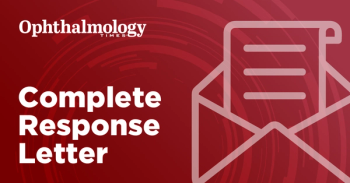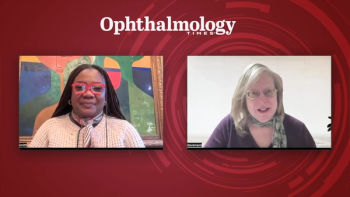
Q&A: AEVR's executive director on #SeeWhatMatters and safeguarding the National Eye Institute
Dan Ignaszewski explains how the national advocacy campaign aims to unite patients, researchers, and clinicians to protect NEI’s independence and ensure vision research funding.
The Alliance for Eye and Vision Research (AEVR), with funding support from Research to Prevent Blindness (RPB), is continuing its push for #SeeWhatMatters, a national campaign opposing proposed National Institutes of Health (NIH) reforms that would consolidate the National Eye Institute (NEI) into a broader institute on neuroscience and brain research. Joining in the effort are national eye and vision organizations that include the American Academy of Ophthalmology (AAO), Association of University Professors of Ophthalmology (AUPO), American Academy of Optometry (AAOpt), Association for Research in Vision and Ophthalmology (ARVO), and the National Alliance for Eye and Vision Research (NAEVR).1,2
Launched in late July, the campaign cautions that such a restructuring could dilute NEI’s focused mission, disrupt dedicated funding, and undermine decades of sight-saving research.1,2
“Vision plays a fundamental role in how we connect with the world around us, shaping how we learn, work, move, and relate to one another,” said Dan Ignaszewski, AEVR executive director. “These proposed structural changes threaten the independence and impact of the NEI, and we need everyone…to share why vision research matters.”
The campaign’s
“Thanks to the unwavering support of RPB, and with the strength and backing of our partners, we are building a movement to ensure vision research remains a national priority,” Ignaszewski said. “We can’t afford to go backward.”
The Eye Care Network caught up with Ignaszewski for more on the campaign’s goals and the stakes for vision research.
What inspired the launch of the #SeeWhatMatters campaign, and why is now such a critical moment for vision research advocacy?
Ignaszewski: The
#SeeWhatMatters is a national call to action. It empowers patients, researchers, clinicians, industry leaders, and advocates alike to stand together and speak out. This campaign is about protecting the future of sight by ensuring that Congress understands what’s truly at stake. Not just for science, but for real people, real lives, and the innovations that give hope to millions living with or at risk of vision loss.
Can you explain how the proposed consolidation of the NEI into a broader neuroscience institute could impact patients, researchers, and the future of sight-saving science?
Ignaszewski: Although the proposed consolidation into a broader brain and neuroscience institute may seem like an administrative change aimed at efficiency, the reality is far more concerning. Such a move would likely create more inefficiencies and reduce transparency, undermining the very progress NEI has made over the past 5 decades. As a dedicated and independent institute, NEI has cultivated a uniquely collaborative research community, rapidly advanced emerging vision science, and supported early-stage investigators.
For patients, this would mean delayed progress in developing treatments or cures for conditions such as glaucoma, age-related macular degeneration, diabetic retinal disease, myopia, corneal dystrophies, and inherited retinal conditions. For researchers, it would lead to decreased grant opportunities, reduced innovation, and the loss of a community that understands the unique challenges of vision science. The future of sight-saving innovation depends on preserving NEI’s status as a stand-alone dedicated to advancing science to protect vision.
The campaign emphasizes that “vision is public health.” How does vision research intersect with broader societal issues like aging, chronic disease, and economic productivity?
Ignaszewski: Vision is often taken for granted, until it's lost. Yet, it’s one of the most vital ways we experience the world, and vision loss significantly impacts daily life. Vision research isn’t isolated. It touches nearly every aspect of our health. Breakthroughs that were pioneered by vision scientists are now used across medical treatments, and the eye itself is emerging as a powerful window into the brain, as well as a diverse array of body systems. Vision research time and again is proving to be a window into whole-body systemic health.
With 50% of the global population projected to be myopic by 2030, we’re seeing an earlier onset and greater risk for long-term complications. Also, with Americans living longer, the prevalence of age-related eye diseases is increasing rapidly and projected to double by 2050. Vision loss is both a cause and a consequence of chronic conditions like diabetes and neurological disease. It leads to greater risks of injury, loss of independence, social isolation, and increased health care costs.
Beyond health, vision impairment directly impacts workforce participation, education and economic productivity. The cost of vision disorders in the US is projected to reach nearly $200 billion annually this year. This number will only climb without investment in vision research that leads to early detection, prevention, and innovative treatments.3
Vision is public health. Protecting it requires sustained, robust funding for research that improves lives now and builds a better future for future generations.
What role can everyday citizens—patients, families, clinicians, and advocates—play in protecting the independence of the NEI, and how does the Advocacy Toolkit empower them to take action?
Ignaszewski: One of the most powerful tools in advocacy is lived experience. The reason the National Cancer Institute receives increased funding year over year is because patients, providers, researchers, and industry leaders come together to speak out. We need to have the same unity within the vision community.
That’s why we created the #SeeWhatMatters Advocacy Toolkit; to make advocacy accessible, actionable, and personal. The toolkit includes step-by-step instructions for contacting Congress, social media templates, and fact sheets to help raise awareness. Because every voice matters to #SeeWhatMatters.
Looking ahead, what does success look like for the #SeeWhatMatters campaign, and how will AEVR continue to champion vision research in the face of policy challenges?
Ignaszewski: Success for #SeeWhatMatters means ensuring vision research remains a national priority. At the heart of the #SeeWhatMatters campaign is a simple but urgent goal: to protect the NEI as a standalone, independent institute within the NIH and to secure the funding necessary to advance life-changing vision research. Launched with support from RPB, this campaign brings together the collective strength of leading organizations in the field—including the AAO, ARVO, AUPO, and AAOpt—in a unified effort to elevate the profile of federally funded vision science.
Success for this campaign doesn’t just mean protecting NEI’s nameplate. It means amplifying the voices of patients, researchers, clinicians, industry leaders, and advocates to ensure that Congress recognizes the essential role NEI plays in public health and scientific innovation. It means driving forward momentum for breakthrough treatments and prevention strategies for diseases like AMD, glaucoma, diabetic retinopathy, inherited retinal conditions, and more.
Together, we’ll continue to engage policymakers through congressional briefings, storytelling, and education, ensuring that the importance of vision research is not only heard but acted upon. Because when we come together to protect what matters, we protect the future of sight for millions. That’s what it means to #SeeWhatMatters.
References
Alliance for Eye and Vision Research launches national #SeeWhatMatters campaign to protect vision research. AEVR. News release. July 22, 2025. Accessed July 31, 2025.
https://www.eyeresearch.org/aevr/alliance-for-eye-and-vision-research-launches-national-seewhatmatters-campaign-to-protect-vision-research Nation’s eye physicians, researchers launch campaign to protect America’s standing as world leader in vision research. ARVO. News release. July 23, 3035. Accessed July 31, 2025.
https://www.arvo.org/news/see-what-matters-campaign#:~:text=This%20week%2C%20we%20launched%20our,what%20it%20means%20to%20%23SeeWhatMatters #SeeWhatMatters advocacy toolkit. SeeWhatMatters.org. Accessed August 5, 2025.
https://www.seewhatmatters.org/#resources
Newsletter
Don’t miss out—get Ophthalmology Times updates on the latest clinical advancements and expert interviews, straight to your inbox.













































